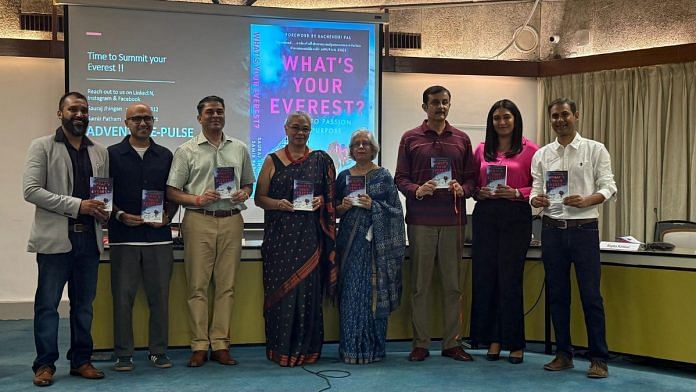New Delhi: In 2013, Sauraj Jhingan and Samir Patham from Mumbai set out to conquer Mount Everest. They trained for years, gave up steady jobs, and poured everything into their goal. But when they arrived at base camp two years later, an earthquake shook Nepal, unleashing a deadly avalanche. Buried beneath snow and silence, they survived. But their story of resilience had only just begun.
“It felt like someone was holding my head from behind and pushing it underwater. I can hear my heart racing, trying to jump out of my chest while I struggle to suck air into my tortured lungs,” writes Patham in his new book, What’s Your Everest: A Path to Passion and Purpose, which he co-authored with Jhingham.
The book, published by Bloomsbury, follows Jhingan and Patham through avalanches and near-summit heartbreaks, showing that real victory isn’t in reaching the top, but in the grit to keep going.
“We often focus only on success, but this book is about failure and not giving up,” said Patham at the launch event in New Delhi’s India International Centre on 27 June.
The first British expedition in 1951 failed. “As Edmund Hillary walked away, he said, ‘I will come back and conquer you, because as a mountain you can’t grow, but as a man, I can.’ Two years later, in 1953, he summited Everest and said, ‘It’s not the mountain we conquer, but ourselves,’” Patham said.
Setbacks, survival
Sauraj Jhingan and Samir Patham did not attempt to leave Nepal after the earthquake, which triggered an avalanche at Khumbu Icefall, claiming 17 lives and wiping out camps. Instead, they remained at Base Camp for seven days, turning their tent into a makeshift relief post, offering food and medicine.
That’s when Jhingan and Patham approached the Indian Army expedition team, camped just 600 metres from their location, intending to seek guidance.
When Jhingan asked the team leader, Major Ranveer Singh Jamwal, what to do next, he discouraged him, saying that the “expedition this year is finished”. But when asked what he would do, the Major replied, “Hum to fauj hai, Bhai [We are the Indian Army]. We will stay and assist with the rescue and relief work.”
In 2017, Jhingan and Patham returned to Nepal – stronger, wiser, but still haunted by the avalanche. They reached the Death Zone – an altitude above which oxygen levels are insufficient to sustain human life – just 800 metres from the top. But 150 km/h winds and thin air forced a heartbreaking retreat.
“So essentially, we failed again– miserably, royally,” Jhingan said. In the book, he writes, “I looked up at Everest in pure despair. After fifty-one days on the mountain, we needed just twelve more hours to reach the summit. I was heartbroken and could only imagine what Sauraj and Vikas (a member of their climbing team) were feeling.”
But they never gave up. In 2018, on their third attempt, Everest seemed to recognise their resolve. On 18 May, after six years of setbacks, the mountain finally opened its doors to them.
Also read:
Passion, perseverance
What’s Your Everest doesn’t shy away from exploring the emotional toll of it all. “Failure is a relentless, crushing force. It seeps into every corner of your mind, whispering doubts and feeding insecurities until you’re left hollow,” Patham writes in the book.
Unlike other sports, mountaineering is not about trophies or roaring stadiums. It’s raw, solitary, and often unforgiving.
“Mountaineering is not a sport, it’s a way of life,” said Brigadier Ashok Abbey, who was part of the panel and is an experienced climber himself. “But very soon, it is becoming a sport, because of rapid commercialisation.”
As mountaineering gains attention, climbers like Jhingan still value its quiet purity–no spotlight, no ceremony, just the wind, the cold, and the knowledge that you made it.
“Passion was what? Look at George Mallory. In the 1920s, he was the most experienced climber. And not just when it came to Everest — he was a real climber. He could climb a 5.10-grade rock. Even today, I’d say 99 per cent of the people who climb Everest couldn’t do that,” Abbey said, referencing the Yosemite Decimal System used to rate the difficulty of climbing terrain.
That same passion took the duo beyond personal goals. Over the years, they’ve shared the mountain with everyone from five-year-olds to 75-year-olds.
“The youngest person we’ve taken to Everest Base Camp was five years old, and the oldest was 75. We once guided someone with a pacemaker–doctors said he couldn’t walk two kilometres, but he finished the camp. At Everest Base Camp, everyone starts fresh, and the trust people place in us means everything,” said Jhingan.
Looking at their journey, Abbey called these failed attempts “partial successes” that actually set the tone for them to come back stronger in 2018. It’s Mount Everest’s way of teaching strategy, humility, and resilience. Not defeat, but preparation.
(Edited by Zoya Bhatti)






